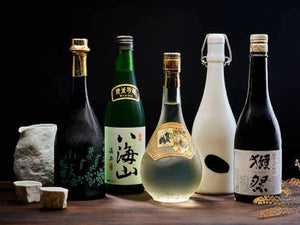
Sake Set for Beginner
Can You Name All Sake Sets?
Sake can be served in a wide variety of vessels, ranging from small sake cups to wooden sake boxes. While you can and should enjoy sake in your favorite set of choice, understanding how different vessels affect the texture and aroma can enhance your experience. Dive into the complete guide to sake sets below!
Sake Cups
When selecting a sake set, keep these three factors in mind:
- Capacity: Sake flavors and aromas change with temperature. A small cup allows you to finish your sake before it cools down or warms up.
- Cup Mouth Width: A wider mouth makes it easier to appreciate the sake’s aroma. This is due to the faster oxidation and volatilization of aromatic elements.
- Cup Shape: Though the impact of cup shapes on taste is debated, many believe the shape directs sake to the optimal area of the mouth. For aroma, especially with aromatic Ginjo types, a bowl-shaped cup allows for swirling and better aroma detection.
Types of Sake Cups
1. Ochoko
A small, cylindrical cup (3-6 cm in diameter) commonly seen in Japanese restaurants. Ochoko often has a broad neck to enhance aroma. It's one of the most widely used sake vessels.
2. Guinomi
Slightly larger than Ochoko, this cup is also best for hot sake, especially when made from pottery with a rough texture.
3. Sakazuki
A wide-mouthed, flat vessel often used in ceremonies, particularly Shinto-related ones. It’s traditionally lifted with two hands and comes in various sizes, usually holding just a few sips.
4. Masu
A wooden square box originally used for measuring rice and sake. Though now mostly ceremonial, using a Masu can add a traditional feel to your drinking experience.
5. Wine Glass
Increasingly popular among sake sommeliers, a wine glass allows you to appreciate the subtle aromas, colors, and viscosity of sake. It’s particularly good for aromatic Ginjo types.
Sake Servers
1. Tokkuri
A flask or carafe traditionally used to warm sake. Its narrow neck helps retain heat. Tokkuri can also be used for cold sake and is often paired with Ochoko in sake sets.
2. Katakuchi
An open-mouthed server suitable for cold and room-temperature sake. Its wide mouth makes it unsuitable for hot sake as it cools quickly. Katakuchi can also serve other beverages or dressings.
Materials of Sake Sets
1. Glass
Ideal for cold sake. The thin rim provides a smooth texture, and wine glasses are perfect for aromatic Ginjo sake.
2. Wood/Bamboo
Adds a traditional minimalist look and subtle woody or bamboo aromas.
3. Ceramic
Heat-resistant and traditional, ceramic is great for hot sake, especially savory Junmai types. Rough textures enhance the experience.
4. Metal
Tin and bronze are excellent for both hot and cold sake due to their heat conductivity.
5. Lacquer
Provides a smooth, lustrous look, suitable for light-bodied cold sake.
The Best Vessel for Each Sake Type
| Sake Cup Type | Sake Type | Note |
|---|---|---|
| Ochoko / Guinomi made of pottery | Junmai, Tokubetsu Junmai, Kimoto | The rough textures and heat resistance of pottery match well with savory, full-bodied sake. Small size ensures you finish before the sake cools or the aroma fades. |
| Wine Glass | Ginjo, Daiginjo, Junmai Ginjo, Junmai Daiginjo | Best for capturing the aroma of fruity, light-bodied sake. Swirl to enhance the fragrance. |
| Any Vessel | Honjozo, Tokubetsu Honjozo, Nama Sake, Nigori Sake | Light-bodied sake with subtle aromas can be enjoyed in any vessel. Avoid glass for Nigori sake as the lees can stick and look unappealing. |

